Lupine Publishers- Environmental and Soil Science Journal
Abstract
Traditional sandy soil stabilizers such as lime cement, fly ash and
bituminous materials, etc., usually require long curing time.
Hence now a day, polymer stabilizer is used more extensively because of
its stable chemical property and shorter curing time.
For the developing organization, it is important to judge the
performance of stabilized soil during its developing stages only. This
paper aims to highlight a quick and easy test to evaluate the mechanical
performance of such polymer based stabilized soil. For this
study, three different kinds of polymer stabilizers at developing stage
were evaluated against a market ready product. The analysis
of the test result include a comparison of the strength, moisture loss
rate and strain energy under different curing time, polymer
type, polymer additive amount and test conditions. This study shows that
the strength of the stabilized sandy soil is significantly
increased both under wet and dry conditions by using the polymer
additives. With the procedure mentioned in the paper it was
easier to identify the relative merits and demerits of each product.
Introduction
In the desert areas, large amount of soil is lifted by wind, the
road is covered by the soil as shown in Figure 1, therefore, soil
stabilization is important for road capacity. Soil stabilization is the
alteration of one or more soil properties, by mechanical or chemical
means, in order to maximize the suitability of soil for a given
construction purpose by improving in-situ soil properties. Soils
may be stabilized to increase engineering properties like strength
and durability; or to diminish erosion and dust generation. The
stabilized product should not only enhance desired soil properties,
but they should also create a soil material/soil system which can
sustain for the design life of the project, under designated load
application. In the field application, the polymer dilution is sprayed
normally into the loose soil. After polymer dilution penetrates
into the soil, compaction of the “wet” soil is carried out. The
stabilized soil gains strength after water evaporates from its soil
mix. Traditional stabilization of soil relies on cement, lime, fly ash,
and bituminous [1-3] material. As the scientists and researchers
are developing new engineering materials, many non-traditional
materials are available for soil stabilization, for examples polymer
emulsion, acids, enzymes and tree resin emulsions [4-7]. As
compared to the traditional stabilizers, these stabilizers have the
following advantages:
a) Stable chemical properties;
b) They produce less swelling and heaving [8,9];
c) Produce less pollution; and
d) They save natural resources.
Apart from above mentioned benefits another advantage is
that the liquid concentrate can be diluted with water and thus it
is easy to achieve target additive amount by controlling dilution
ratio. In many countries, large percentages of roads and parking
lots are unpaved. The vehicles and wind together with the loose soil
create dust that are known for adverse environmental and human
health impact. Apart from increasing the strength of the soil these
stabilizers can also be used as a way for controlling dust. For the
ease of transportation and storage these Polymer emulsions can
also be prepared in the form of powder. Before field application
it is important for the industries to understand the mechanical
properties of stabilized soil primarily during development phase of
the product. Thus, the main objective of this paper is to highlight a
quick and easy way to evaluate the mechanical performance of such
stabilized soil before actual field application. Such assessment will
quickly provide them a guide to modify their product if at all needed.
For a comparison study, three in development products from the
same company namely a) L13126; b) L13140; c) L13142 and one
a market ready “Product A” is chosen, all as anonymous reference
products. Overall, they constitute three polymer emulsions and one
polymer powder type as described later in the paper. Goals within
the scope of this paper include the following:
a) In detail description of sample preparation
b) To evaluate the property and suitability of the sandy
soil before the addition of stabilizer developed by chemical
polymerization techniques
c) To evaluate the property and suitability of the sandy soil
after the addition of the stabilizer
d) To investigate the influence of the mechanical properties
of the sandy soil with the polymer emulsion (in terms of mix
proportion, percentage of stabilizing additive, water content
and permeability of the stabilized soil matrix)
e) To demonstrate the influence of the emulsion types,
curing time and wetting condition on the mechanical response
of the stabilized soils
f) At last, present a relative ranking of various soil stabilizer
products
The outcome of the tests is analyzed in terms of unconfined
compressive (UC) tests. It is hereby noted that other tests such
as California Bearing Ratio (CBR) [10,11], triaxial (confined and
unconfined), resilient modulus, and cyclic wet dry tests are also valid
tests to investigate the performance of the stabilized soils. However,
for a rapid screening of stabilizers, the UC test was preferred. In this
investigation, the compacted stabilized sandy soil samples were
‘cured’ under controlled temperature and humidity conditions
before the soaked and un soaked unconfined compressive strength
(UCS) tests were performed.
Material and Method
Materials Used
Four different kinds of stabilizers were used in this study, three
polymer emulsion type namely: L13126, L13142 and Product A
and one powder polymer type namely: L13140. Table 1 lists the
polymer type and solid content of individual emulsion type, which
was obtained by drying a known weight of emulsion in the oven
at 1050C to a fixed weight. The sandy soil samples which contain
10% china clay and 90 % sand were considered which more or less
represent a dust prone unpaved soil road. The sand used in this
research is natural sand in Netherland, the gradation is showed in
Figure 2.
Specimens Preparation
In order to perform compression tests, cylindrical specimens of
100 mm diameter and 150 mm height were prepared. The optimum
moisture content of the sandy soil without stabilizer was measured
by the modified proctor method (ASTM D1557). Figure 3 shows
the result of modified proctor test. From the plot of the Figure 3, it
can be observed that the optimum moisture content of this sandy
soil is about 10.3%. With the known optimum moisture content
and the known maximum dry density of the sandy soil, gyratory
compactor was utilized (at 600kPa vertical stress, 30 gyrations/ min and
1.250 tilt angle) for the preparation of specimens. In order
to mix the polymer stabilizer and soil uniformly, the stabilizer
concentrate was diluted in the water before putting it into the
sandy soil mixture. The dilution ratio was based upon the optimum
moisture content and the amount of stabilizer used. For providing
enough space for the polymer concentrate in the soil matrix, the
stabilizer amount and the amount of water to be added is calculated
on the basis of the optimum moisture content i.e. 10.3%. The
actual density of polymer emulsion was assumed to be 1Kg/L. The
preparation of sample was carried out in following six steps: soil
preparation, additive preparation, soil-additive mixing, moulding,
compaction, curing. The soil was mixed for five minutes before the
addition of dilution. The amounts of added stabilizer were 14L/m3
(i.e. 1 m3 compacted soil contains 14L stabilizer concentrate), 19L/
m3 and 24L/m3 respectively. The dilution ratio was calculated by
the following equation:
where: R: dilution ratio
x: optimum water content (%)
y: maximum dry density of soil (Mg/m3)
z: amount of adding polymer (L/m3)
ρ: the density of stabilizer in the test temperature (Mg/L)
Assuming the depth of penetration in pavement to be 15 cm,
the amount of addition of stabilizer i.e. 14L/m3, 19L/m3, 24L/m3 is
equivalent to 2.1L/m2, 2.85L/m2, 3.6L/m2 respectively. After the soil
and additive preparation steps, the dilution was mixed with sandy
soil by using rotary mixer, until a uniform mixture was achieved.
The specimen was prepared by using a gyratory compactor mould
of 102 mm diameter and 254 mm height. The material was placed
in three layers in the mold and each layer was compacted with rod
for 25 times in order to get a uniform specimen. After molding step,
the sample was placed in the gyratory device and compacted until
the height of the sample was reduced to 150 mm. The compacted
sample was then extruded from the gyratory mould by the
hydraulic jack extrusion device mounted on the gyratory machine.
The compacted sample was then placed in the curing room at 200C
and 40 percent relative humidity. In order to simulate the field
condition, air-dried curing process was used. Each sample was
weighed after 3 days, 7 days, 14 days, 21 days, and 28 days to get
the moisture loss rate.
Unconfined Compression Test
The sandy soil samples stabilized with the different type and
number of additives were tested by using unconfined compression
(UC) setup under soaked and un soaked conditions. In the soaked
UC test, the dry sample was placed in the 25 mm deep water bath
for 15 minutes and after removing it from the water it was drained
for 5 minutes. Then the soaked samples, as shown in Figure 4, were
tested. The soaked UC test reflects the influence of moisture on the
strength reduction of the stabilized soil in the field condition.
Permeability Test
Permeability test was conducted to evaluate the capability of
the stabilized soil samples to allow the water pass through it. The
falling water head setup, see, is used for measuring permeability
of the sandy soil samples with different types and amounts of the
additives. In this test a sample is connected to a standpipe which
provides both the water head and the means of measuring the
quantity of water flowing through the sample. The permeability
value is calculating by using the following formula:
Where: Kt: permeability(m/s)
a: cross section area of used manometer tube (cm2)
A: cross section area of sample in permeameter cell (cm2)
t: measured time interval (s)
L: length of sample (cm)
h1: start level manometer tube distance above overflow level
(cm)
h2: end level manometer tube distance above overflow level
(cm)
The parameters a, A, L were calculated on the basis of geometry
of the samples and the manometer tube. The test was carried out
after the sample was fully saturated. After that, the water tube is
filled to a prescribed starting level h1. After t seconds, the water head level 2 in the manometer tube is recorded. By using the
equation mentioned above the permeability Kt is calculated. The
procedure is repeated at least three times interval until the Kt value
is constant.
Results and Discussion
Optimal Polymer Adding Amount
Preliminary test was conducted to get a reasonable amount of
stabilizer quantity to be investigated, L13126 polymer was taken as
an example, various additive amounts of 0L/m3 (pure water), 1.5L/
m3, 7L/m3, 14L/m3, 19L/m3 and 24L/m3 stabilizer quantity were
examined. Figure 5 shows a plot of the additive amount versus UCS
results after 28 days curing. As shown in Figure 5, the compression
strength increases with stabilizer adding amount, it is expected that
higher polymer content leads to thicker polymer matrix and more
interaction between the soil particles, the compression strength
increase almost linearly. It is hereby defined that “incremental
strength” means the UCS of stabilized sample deducted by the
UCS of samples with pure water. According to the Netherlands
specification, the minimum UCS of bounded base layer shall be not
less than 2MPa. Therefore, in this investigation, the incremental
UCS value of 2 MPa was set as our minimum strength requirement.
As can be seen from the prediction curve of Figure 5, the stabilized
soil with 19L/m3 additive amount can reach 2 MPa. Therefore, the
additive amount around 19L/m3 i.e. 14L/m3 and 24L/m3 and at
19L/m3 were investigated in the new test plan for all the polymer
stabilizers.
Polymer Adding Amount Effect
Figure 6 presents the UCS of sandy soil sample stabilized with
different type and different adding amount after 28 days curing
period. All the stabilized sandy soil demonstrated remarkable
increase in UCS than the sample mixed with only pure water. The
highest UCS value after 28 days curing period was found for Product
A stabilized sandy soil which was higher than the sample stabilized
by L13126. The L13140 and L13142 stabilized sandy soil show
almost similar UCS values. However, as compared to the L13126
and Product A, these two stabilizers display lower UCS values. It is
also noted hereby that UCS value increased with the increase in the
stabilizer adding amount.
Wet and Dry Condition Effect
The soaked UCS of the sandy soil samples with pure water
were not able to be tested because the samples disaggregated
in the water bath. For comparison of moisture sensitivity of the
samples, the strength loss rate of different stabilized samples was
determined as Figure 7 In general, it can be observed that the
strength loss rate decreases with the increase in the stabilizers
amount, it indicates the thicker polymer coating will prevent
moisture diffusion better. L13140 powder polymer specimens
provide better water resistance to moisture deterioration and lose
about 20% compression strength, the compression strength loss
rate of others stabilizer specimens is about 30%. The specimens
without stabilizer begin to disintegrate when they are placed in the
water, and then lose load bearing capacity, the polymer can improve
the water resistance of sandy soil.
Curing Time and moisture lose effect
The effect of curing time on residual moisture rate is presented
in Table 2, the value is based on the original water adding weight
and the water loss weight. The samples were weighted after 3, 7, 14, 21
and 28 curing days, as shown in Table 2, the residual moisture
rate became a constant, almost all the moisture has evaporated by
the 14th day of curing for all the stabilizer specimens with different
adding amount, the final value is not zero duo to the moisture loss
in the mixture process. Comparing the values of specimens with
stabilizer and pure water, the different is slight, it illustrates polymer
do not affect the moisture evaporation. The moisture evaporates
from the sample that will enhance the bonding between polymer
and soil particles, the relation between compression strength
and residual moisture rate are shown in Figure 8, duo to residual
moisture rate decrease with curing time for all the specimens is
similar, for brevity, the residual moisture rate result of pure water
sample is taken as an example to compare with the compression
strength variation. The sample with polymer stabilizers develop
approximately 60% of the 28 days compression strength within the
first 7 days of curing, however, the strength growth after 14 days
curing period is not significant, the strength growth trend is similar
to that of residual moisture rate decrease, this indicates that the
gain in strength of the stabilized sample may only be related to the
rate of moisture evaporation and not to any chemical reaction as
normally observed in cementitious stabilized products.
The moisture in the stabilized sample will influence the soaked
UCS loss rate, the effect of curing time on USC loss rate is shown in
Figure 9. In general, the USC loss rate decrease with the increase
of curing time, the trend is similar to that of strength growth,
it illustrates the sample with less moisture inside has a better
moisture damage resistance. Samples utilized for permeability test
were prepared in the same method as the ones used in the UC test
(refer to “Specimens preparation” section). As shown in Figure 10,
sample is kept inside the tube with no side flow allowed and the
bottom 2 cm of the sample is utilized to apply silicon glue. After
filling up the tube with water the test equipment is left for one day
to be able to fully saturate the sample. The permeability test was
carried out on the samples stabilized by L13126, L13140, L13142
and Product A with 19L/m3 additive amount, 3 replicates for
each case, the permeability results are presented in the Table 3. It
can be observed that all the sandy soil samples stabilized by the
polymer stabilizers show lower permeability which is important
for pavement surface layer to prevent rain water infiltration into
the deeper part of the road foundation, soil stabilized by L13142
show highest permeability.
Implication and Discussion
Polymer is an environmental way for dust control and soil
stabilization, as important as dust control, the mechanical and
hydraulic property are also key points of polymer application, in
this paper, mechanical and hydraulic property include three key
indexes: UCS, soaked UCS loss rate and permeability, after 28 curing
days, the moisture evaporate from the stabilized soil, the specimens
become stronger and have a lower UCS loss rate. Unfortunately,
there are no significant relation between the three indexes for all
the polymers, the highest UCS is product A, the lowest UCS loss rate
is L13140, and the lowest permeability is L13142, therefore it is
hard to find a polymer with higher UCS, lower UCS loss rate and
lower permeability, for the application, field condition, strength
requirement and cost should be considered for stabilizer selection.
Conclusion
This paper in detail describes a quick and easy way, from
sample preparation stage to experimental tests, to evaluate the
performances of four kinds of stabilizers on sandy soil. With the
results obtained from the tests one can examine the relative
performances of various stabilizers. Such tests can be performed
during product development phase itself. For example, from all the
samples examined, tests results indicated that soil stabilized by
L13126 has higher UCS both in soaked and un soaked conditions
than the one stabilized by L13140 and L13142 and it is comparable
to market ready Product A. The 28 days UCS of sandy soil samples
stabilized by using 19L/m3 of L13126 and Product A can reach
to a desired value of 2 Mpa (as per recommendation). Sandy soil
stabilized by polymer powder L13140 is slightly stronger than the
one stabilized by the polymer emulsion L13142. Such information
can be used in the ranking of various products. Other findings
that can be drawn from the results presented in this paper are
summarized as follows.
a) This study shows that the strength of the stabilized sandy
soil is significantly increased both under wet and dry conditions
by using the polymer additives.
b) The UCS values of the sandy soil samples demonstrate
that the polymer-stabilized soil properties improve with the
curing conditions and the additive amount.
c) The increase in strength is observed due to the deposition
of the solidified polymer components after water evaporates
from the emulsion. The amount of polymer deposited on the
surface of the soil particle depends on the concentration of the
polymer and to the degree of mixing.
d) The compressive strength growth rate of the stabilized
soil correlates with the moisture loss rate in the sample. There
is no further strength increase when sample completely loses
its moisture.
e) After 14 days, most stabilized soil samples reach the
maximum compressive strength.
f) As compared to the cement & lime stabilized soil in
literature, the stabilized soil sample shows higher deformability.
g) Sandy soil sample stabilized by the polymer stabilizers
show lower permeability.
Follow on Linkedin : https://www.linkedin.com/company/lupinepublishers
Follow on Twitter : https://twitter.com/lupine_online

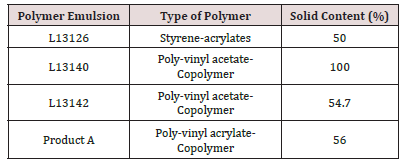
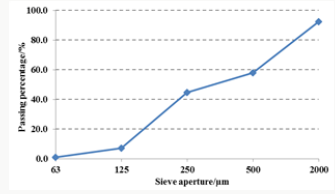
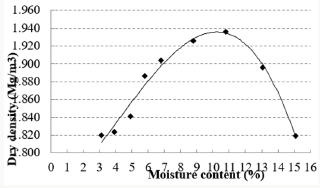
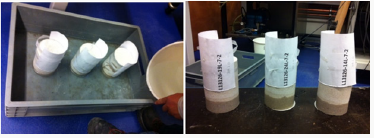


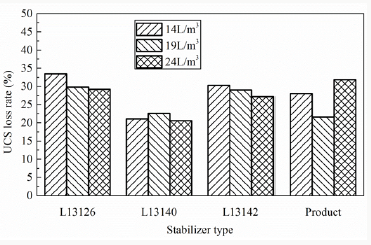


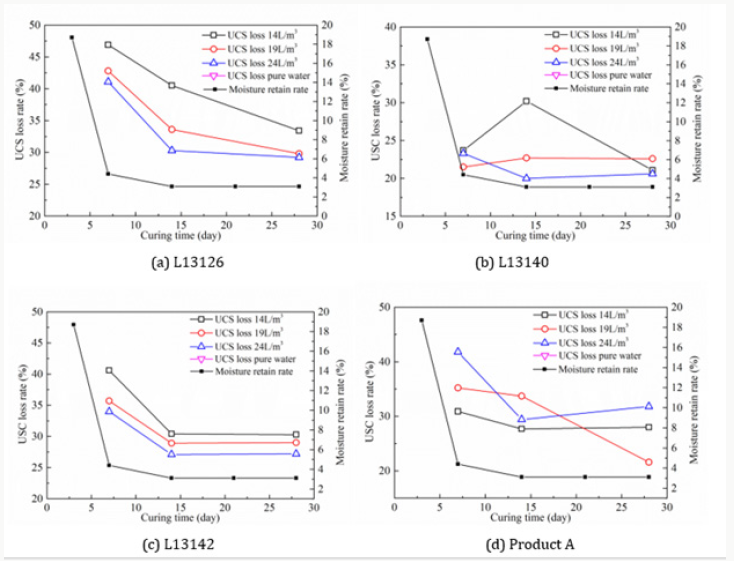
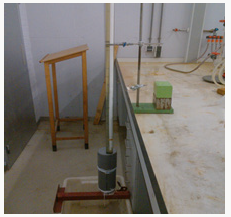
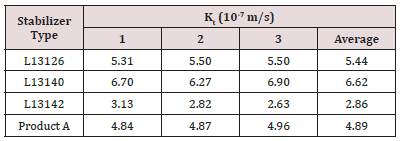
No comments:
Post a Comment
Note: only a member of this blog may post a comment.